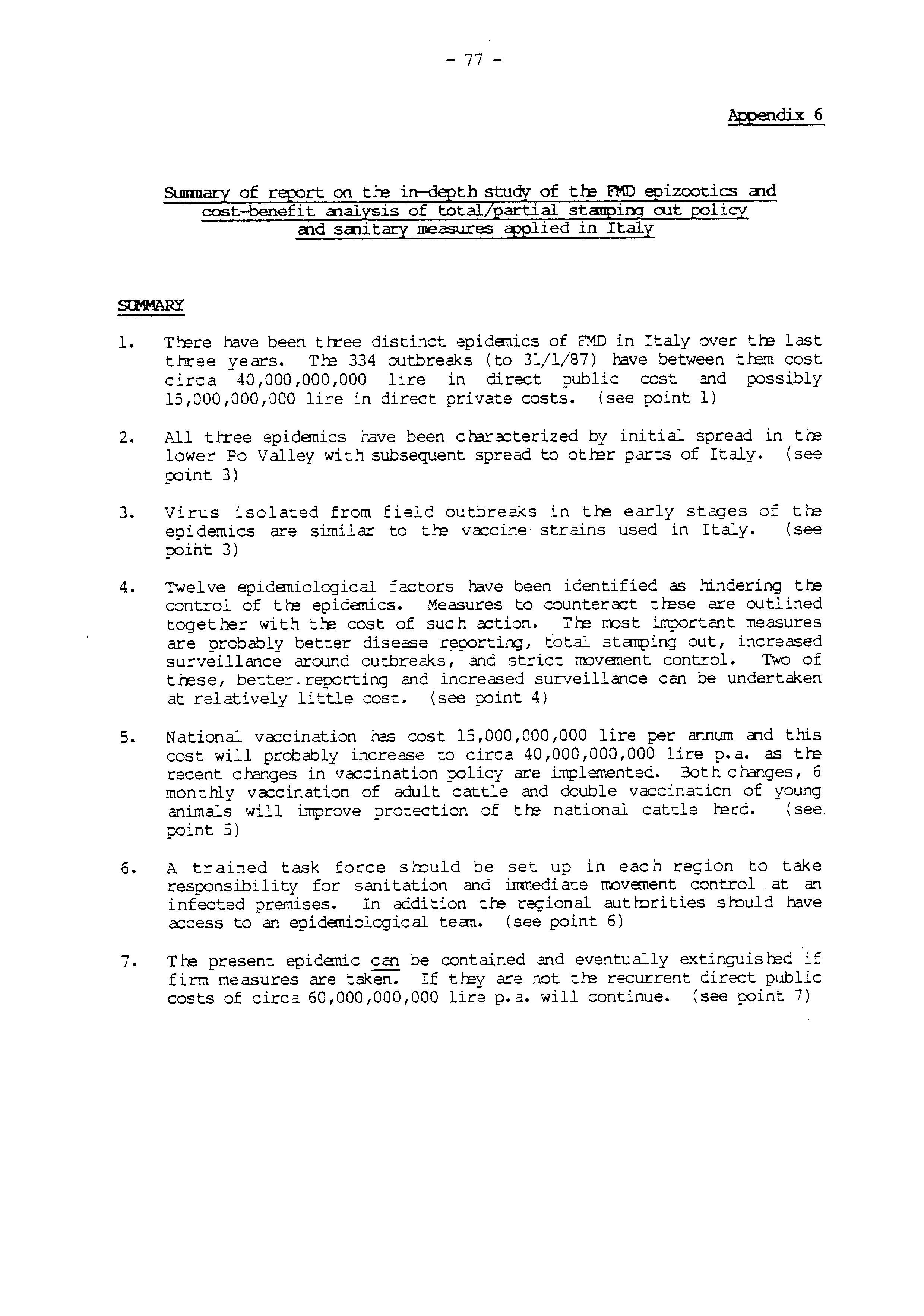
13 minute read
applied in Italy
Appendix 6
cost-benefit aialysis of total partial stanping a.It e?licy ai.d sa1itary measures c.£Plied in Italy
Advertisement
S(M,!ARY
1. Th:re have been th:"ee distinct epide:nics of FMD in Italy over th: last three years. Tre 334 outbreaks (to 31/1/87) have between th:m cost circa 40,000,000,000 lire in direct public cost and i;ossibly 15,000,000,000 lire in direct private costs. (see point 1)
2. All t.1-ree epidenics r.ave been chara::terized by initial spread in tre lower Po Valley with subsequent spread to otrer parts of Italy. (see _i;:oint 3)
3. Virus isolated from field outbreaks in tre early stages of th: epidemics are similar to tre vaccine strains used in Italy. ( see poiht 3)
4. Twelve epideniolcgical factors have been identified as hindering tre control of tre epidenics. Measures to counteract trese are outlined together with tre cost of such a::tion. Tre rrost important measures are probably better disease reporting, total stanping out, increased surveillance around outbreaks, and strict rrovement control. Two of trese, better. reporting and increased surveillance can be undertaken at relatively little cosc. (see _i;:oint 4)
5. National vaccination has cost 15,000,000,000 lire per anmnn and this cost will probably increase to circa 40,000,000,000 lire p.a. as tre recent changes in vaccination i;olicy are implemented. Both cr.anges, 6 monthly vaccination of adult cattle and double vaccination of young animals will improve prot.ection of tre national cattle rerd. ( see i;oint 5)
6. A trained task force s rould be set up in each region to take responsibility for sanitation and immediate movement control at an infected premises. In addi-:.ion th: regional autrorities srould have cecess to an epide:niolcgical tean. (see point 6)
7. The present epidenic can be contained and eventually extinguis red if firm measures are taken. If th:y are not tre recurrent dir-ect public costs of circa 60,000,000,000 lire p.a. will continue. (see point 7)
_1. Description of epidanics
Tre foot-and-rrouth disease outbreaks that r.ave occurred in Italy since 1984 can be divided into three distinct epidemics.
( a) (b)
(c)
November 1984 - August 1985 November 1985 - April 1986 June 1986 to date
Type "A" Type "C"
Type "A"
153 outbreaks 69 outbreaks 112 outbreaks (to 31/1/87)
2. Tre direct cost of tre epidenics
TIE approximate cost of ttese epidemics is:
"A 11 1984/85 "C" 1985/86 "A1 ' 1986/77 (to 31/1/87) Direct public costs+ '000 lire 5,500,000 11,000,000 20,000,000
Direct private costs* '000 lire
3,000,000 - 5,000,000 3,000,000 - 5,000,000 5,000,000 - 7,000,000
+ t.tE direct nublic costs include: ( a) canpensation for slaughtered animals (b) sanitary measures on far.ns (cl local administrative costs (including surveillance) {dl va:cination around outbreaks
* The direct private costs are: estimates based on British and German estimates of lost production in infected terds.
3. Tre pattern of spread of tre epidanics
Tte pattern of t.tE t.rree epidanics is similar:-
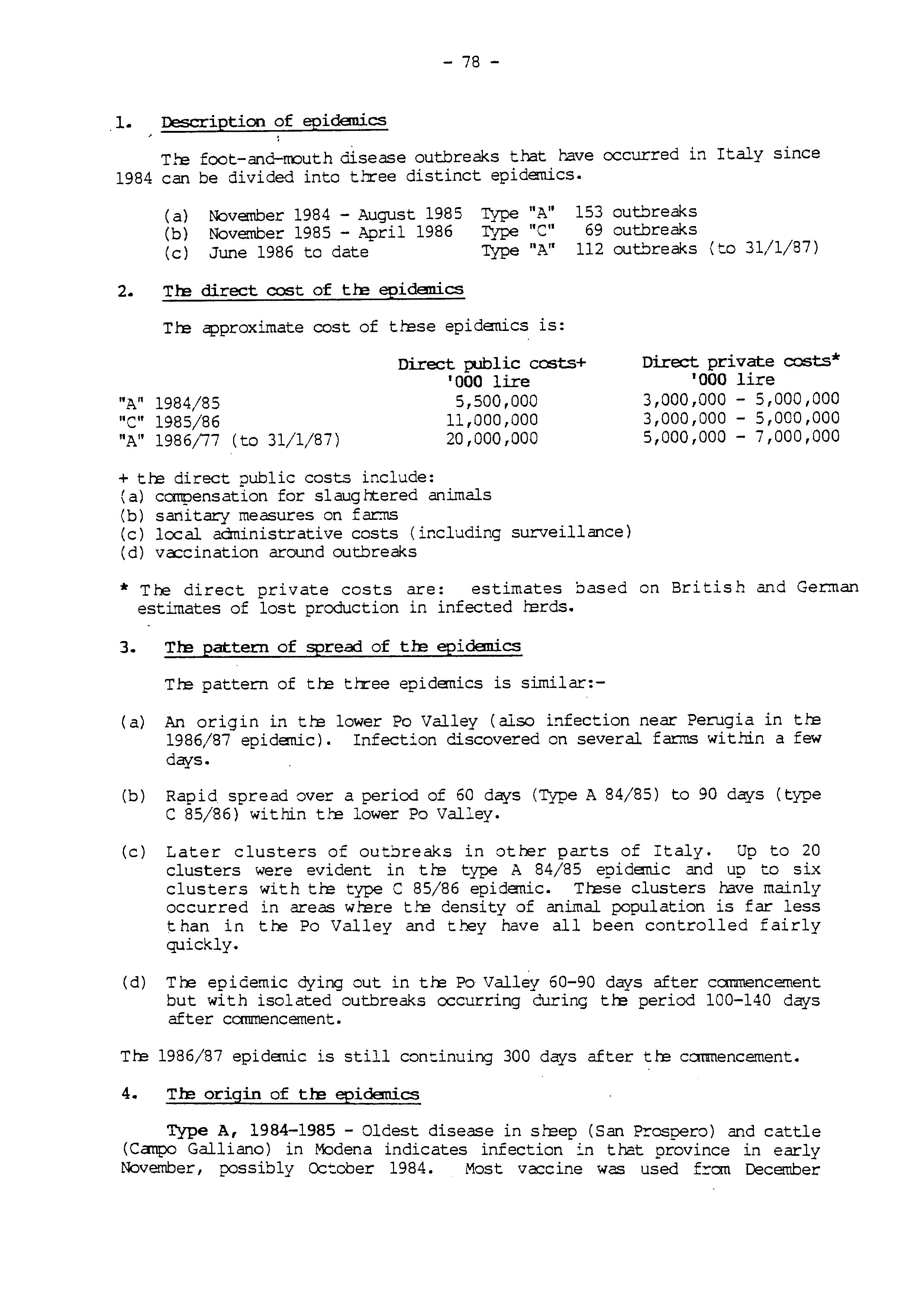
( a) An origin in tte lower Po Valley ( also infection near Perugia in tte 1986/87 epidemic). Infection discovered on several farms within a few days.
(bl Rapid spread over a period of 60 days (Type A 84/85) to 90 days ( type C 85/86) within tte lower Po Valley.
(c) Later clusters of outi)reaks in other parts of Italy. Up to 20 clusters were evident in tte type A 84/85 epidemic and up to six clusters with tte type C 85/86 epidemic. Tt:ese clusters have mainly occurred in areas wtere tte density of animal population is far less than in the Po Valley and they have all been controlled fairly quickly.
(d) The epidemic dying out in tre Po Valley 60-90 days after canmencement but with isolated outbreaks occurring during tre period 100-140 days after canrnencement.
TIE 1986/87 epidemic is still continuing 300 days after tre camnencement.
4. Tre origin of tre epidemics
Type A, 1984-1985 - Oldest disease in steep (San Prospero) and cattle (Canpo Gallianol in Modena indicates infection :n that province in early November, possibly October 1984. Most vaccine was used £::an December
onwards. Isolates £ran late November, early Dece.rnber and January were all indistinguishable: £ran A~ Parma/62 virus - t.l-:e Italian vaccine strain.
Type C, 198~1986 - First reported outbreak in pigs (Canpo Galliano, Modena) is unlikely to have been pr:.mary. An isolate from Rubier a (Modena) (3/12/85) indistinguishable £ran Brescia/64 by TI :napping at Pirbrig ht laboratory but differed on reat lability tests at Brescia laboratory. Primary focus unknown.
Type A, 1986-1987 - First outbreaks reported sirm.lltaneously 6 June 1985 in pig farms at Mantova and Perugia; possibly linked by transport. Pirbright and Brescia laboratories agree that isolates fran this epidemic are undistinguishable fran A5 Parma/62 strain. S. Fa:tors influencing spread of infection
( a) Reporting of disease
Reporting by farmers is late or not at all. This allows infect.ion to spread widely within rerds and also ':Jetween rerds before it is detected.
(b) Dic.gnosis
Mild disease in cattle and confusion with SVD has resulted in sane delays in recognizing disease in tte field. Laboratory diagnosis is generally satisfactory.
(c) Sla.1g tter e:,licies
Policies differ between regions. Wrere complete slaughter has been used most often, as in Piem::mte region, t.l-:e disease has been contained. Guidelines for partial or complete slaug li:.er are not strictly followed. Partial slaugli:.er in sane cases means repeated, fr~nted slaugli:er. Complete slaugh:er is usually tl:e · last resort wren morbidity is evidently high.
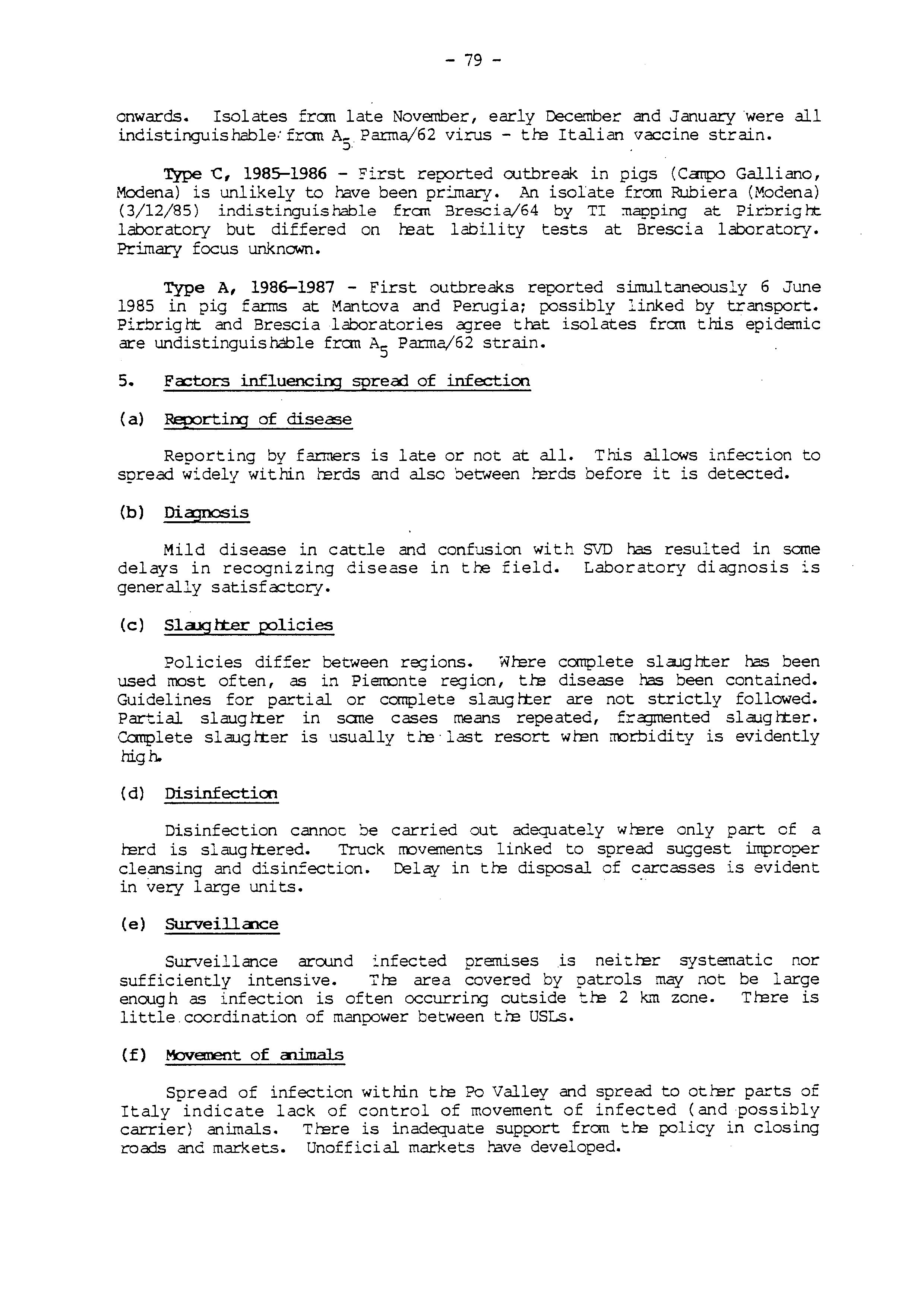
( d) Disinfectioo
Disinfection cannot. be carried out adequately wtere only part of a terd is slaug li:.ered. Truck rrovernents linked to spread suggest improper cleansing and disinfection. Celay in tre disposal of carcasses is evident in very 1 arge uni ts.
(e) SUrveilla1ee
Surveillance around :nfected premises is neit.l-:er systematic nor sufficiently intensive. Tre area covered by patrols may not be large encug h as infection is often occurring cutside t.l-:e 2 k.'11 zone. T rere is little.coordination of manpower between tte USLs.
{f) Movement of a:rima1s
Spread of infection within tre Po Valley and spread to otter parts of Italy indicate lack of control of movement of infected (and possibly carrier) animals. Trere is inadequate support fran tte policy in closing roads and markets. Unofficial markets have developed.
( g} Airborne spread
Tre density of animals in tre Po Valley and temperature inversions during winter rrontra suggests that some airborne spread is occurring. One pig rnlding visited during tre mission had alrrost ideal precautions to prevent access but infection spread to it probably fran an infected premise 3 km distant.
( h) Spread by personnel
Spread of infection has been associated with veterinarians (unkncwingly c:onta:ninated) wro have carried out A. I. and embryo t.:::-ansplant procedures. Spread is also being associated with rodent exterminators visiting fanns.
(i) Population densities
Tre Po Valley has one of t.re higrest densities of pig and cattle populations :.n Europe. Tre close proximity of large camnercial pig rerds end veal calf uni ts has aided disease dissemination and made decontanination and tre disposal of carcasses and effluent difficult.
( j ) Vaccination
Vaccination cover was originally less than complete but it has now improved. Tre cattle i;:opulation now includes a large prcportion of young animals many of w hie h are imported. T h:se imported ani.'1lals fre<;uentl y have inadequate levels of maternal antibody and young stock as a w role provide a large pool of susceptible animals. Alt.rough imported animals smuld be identified for vaccination, break.downs of c::mmunications between USLs mean that tre calves are not traced and vaccinated. Lack of ·restraint on fanns encoura:_;;es the use of jet applicators for vaccination.
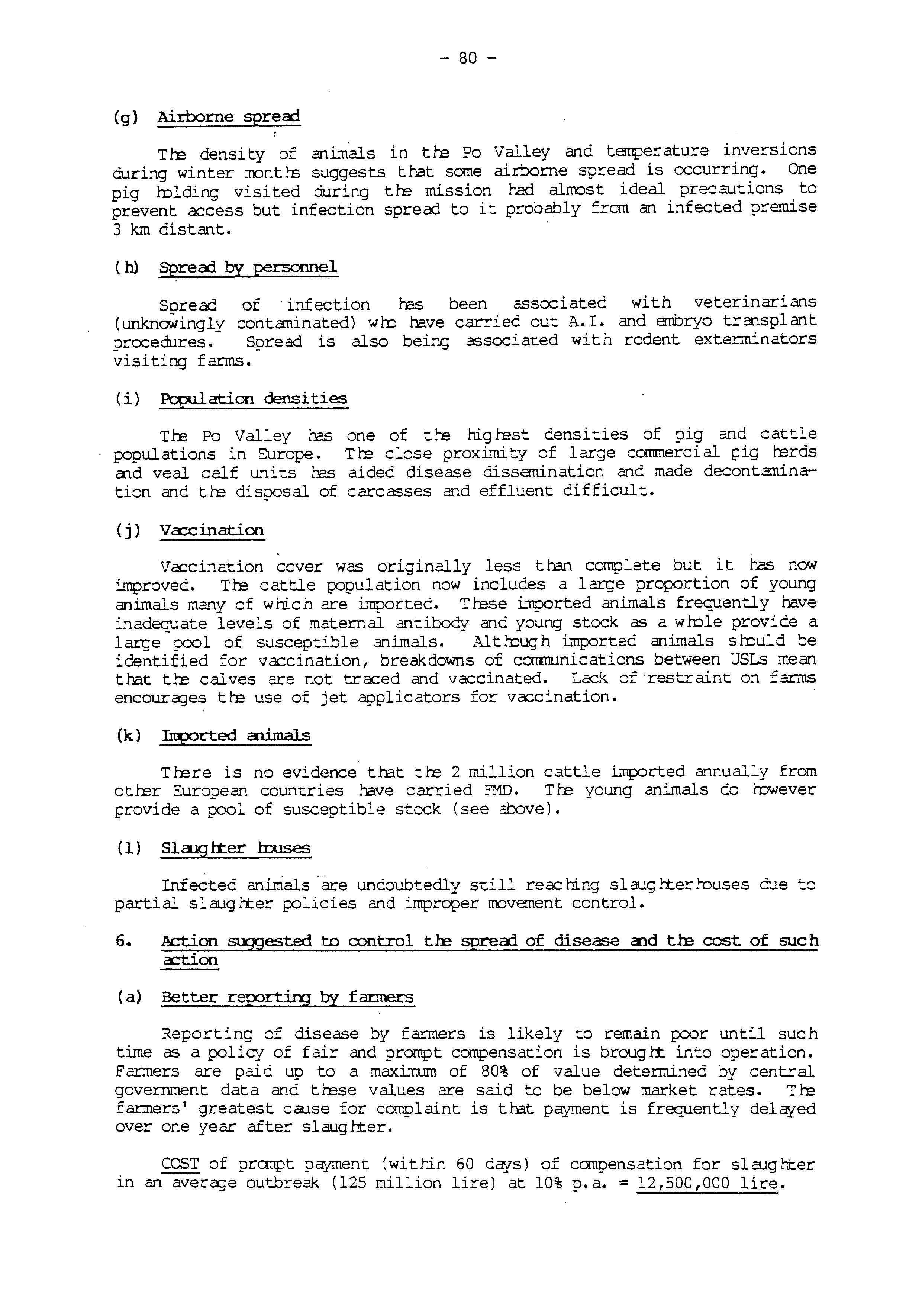
(k) Toported a,imals
Trere is no evidence that the 2 million cattle imported annually from otrer European count.ries have carried P.-ID. The young animals do rowever provide a i;:ool of susceptible stock (see above).
(1) Sla.1glter lrnses
Infected animals ·are undoubtedly st.ill reaching slaugh:errouses cue to partial slaug It.er policies and improper rrovement control.
6. Action suggested to control tl:e spread of disease aid tl:e cost of such
a::tion
(a) Better rep::,rting by farmers
Reporting of disease by farmers is likely to remain IXXJr until such time as a policy of fair and prompt ccmpensation is broug .!t into operation. Farmers are paid up to a maximum of 80% of value determined by central government data and trese values are said to be below market rates. T re farmers' greatest cause for ccrnplaint is that payment is frequently delayed over one year after slaughter.
COST of 9ranpt payment (wi t.hin 60 days) of canpensation for sla.rg ht.er in an avera:_;;e outbreak (125 million lire) at 10% p.a.= 12,500,000 lire.
Farmers failing to rer:ort disease smuld be prosecuted. (b) Sla.,glt.er of all susceptible stock on a mlciirXJ
A r:olicy of canplete "sta:nping-out" will reduce tre spread of infection and s 1-ould be followed on all infected premises irrespective of tre apparent weig li:. of infection, t.I-:e vaccine status of t.I-:e animals or t.I-:e arrangements of tre buildings.
COST - T re direct public cost of recent ( 86/87) outbreaks under tre present policy of partial slaughter is estin1ated at 178,289,000 lire (per outbreak). T re cost if all stock are slaughtered is estimated at 537,235,000 lire.
Trerefore tre extra cost of tot.al slaughter (per outbreak) is:
537,235,000 - 178,289,000 358,946,000 lire
This is tte extra public cost. In addition ttere is substantial extra private cost due to loss of production.
(c) Increased surveilla:ice aroo.nd infected pranises
Increased and systematic surveillance around infected premises is required so as to identify foci of disease. Two actions are necessa..ry -
( a) Increased manpower. It is estimated trat circa 40 man days, per outbreak are spent at tre infected premises, in local surveillance and in office duties. If total slaughter were introduced tre manpower at tre infected premises would be reduced (say by 10 man days). A furc.rer 40 man days per outbreak smuld be devoted to surveillance.
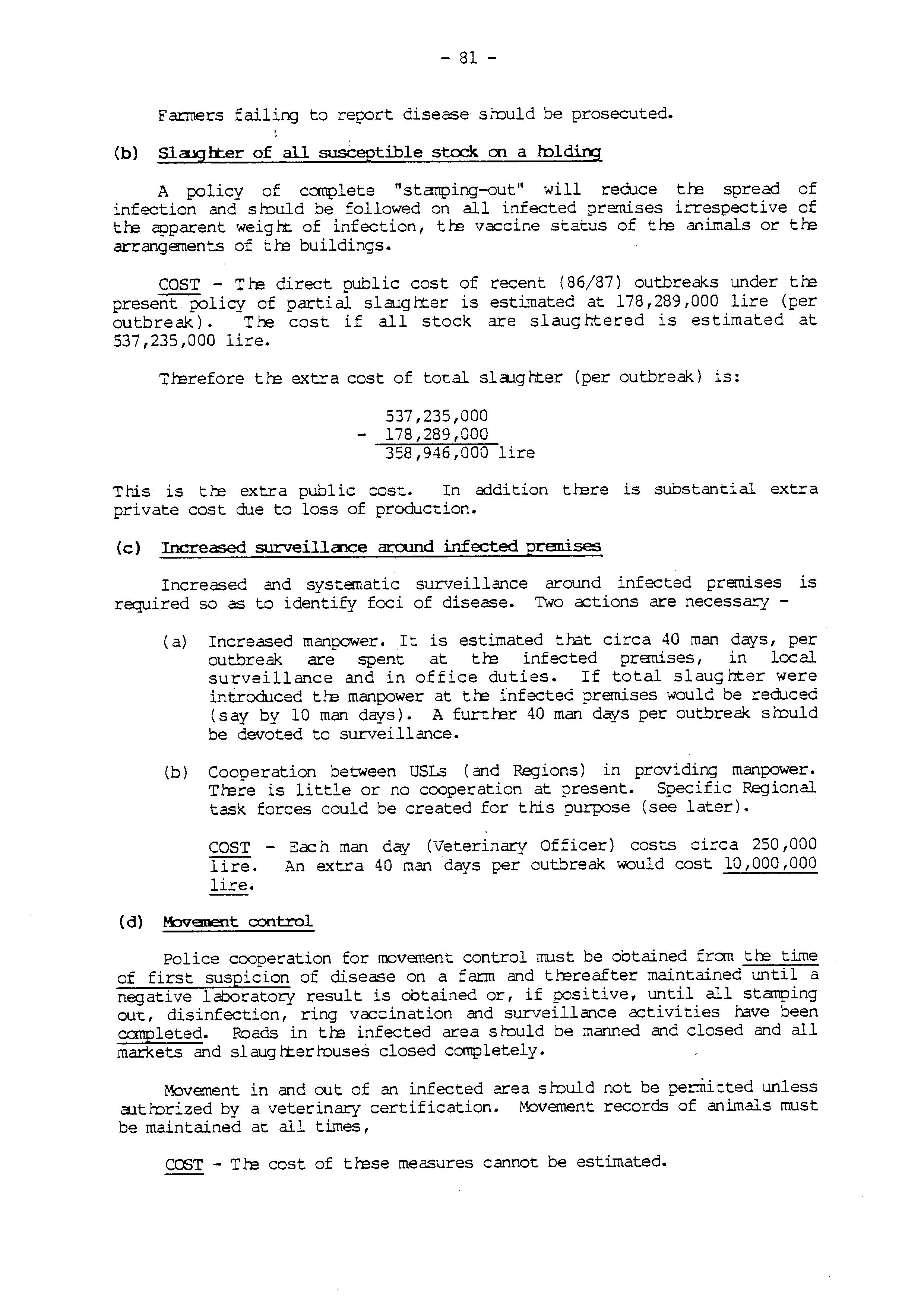
(b) Cooperation between USLs ( and Regions) in providing manpower.
Trere is little or no cooperation at 9resent. Specific Regional task forces could be created for this purpose (see later).
COST - Each man day (Veterinary Of::icer) costs circa 250,000 lire. An extra 40 man days per outbreak would cost 10,000,000 lire.
(d) !½:)venent control
Police cooperation for rrovernent control must be obtained frcm tre time of first suspicion of disease on a farm and trereafter maintained until a negative laboratory result is obtained or, if p::,sitive, until all stamping out, disinfection, ring vaccination and surveillance activities have been canpleted. Roads in tl'E infected area sl-ould be manned and closed and all markets and slaug It.er rouses closed completely.
Movement in and out of an infected area srould not be per:nitted unless autror::.zed by a veterinary certification. Movement records of animals must be maintained at all times,
COOT -T h9 cost of tl'Ese measures cannot be estimated.
{e} Va:cination
All cattle srould be vaccinated at tre a:;;;e of 3 rrontra and revaccinated one nonth later. Vaccination srould· be by syringe and needle only and rand::m serolcgical c.tecks srould be carried out for verification. In view of tre current weight of infection in tre country all cattle over three months of age shJuld be vaccinated at six monthly intervals. Vaccination of pigs srould be limited to infected zones and no vaccination of animals shJuld be carried out on premises where disease has been ccnfirmed. Used vaccine bottles are being stored. They shJuld be discarded.
CCST - Tre cost of vaccination of t.te national .terd is: 1984 - 11,150,000,000 lire (official data) 1985 - 15,192,000,000 lire (offic;i.al data) ..
T.te number of doses produced in 1986 was 19,500,000 (Brescia: 12 million cattle ooses, 2 million pig doses; Padua: 3,500,000; Perugia circa 2,000,000).
I:: all adult animals are vaccinated evecy six rrontra and all young stock are given an extra dose tre likely cost is: 1987 - 40,000,000,000 lire
Trese costs include t.te cost of t.te vaccine and tre ccst of adninistering it.
(f) Di~is and epidemiolo;;ical investigatiCXlS
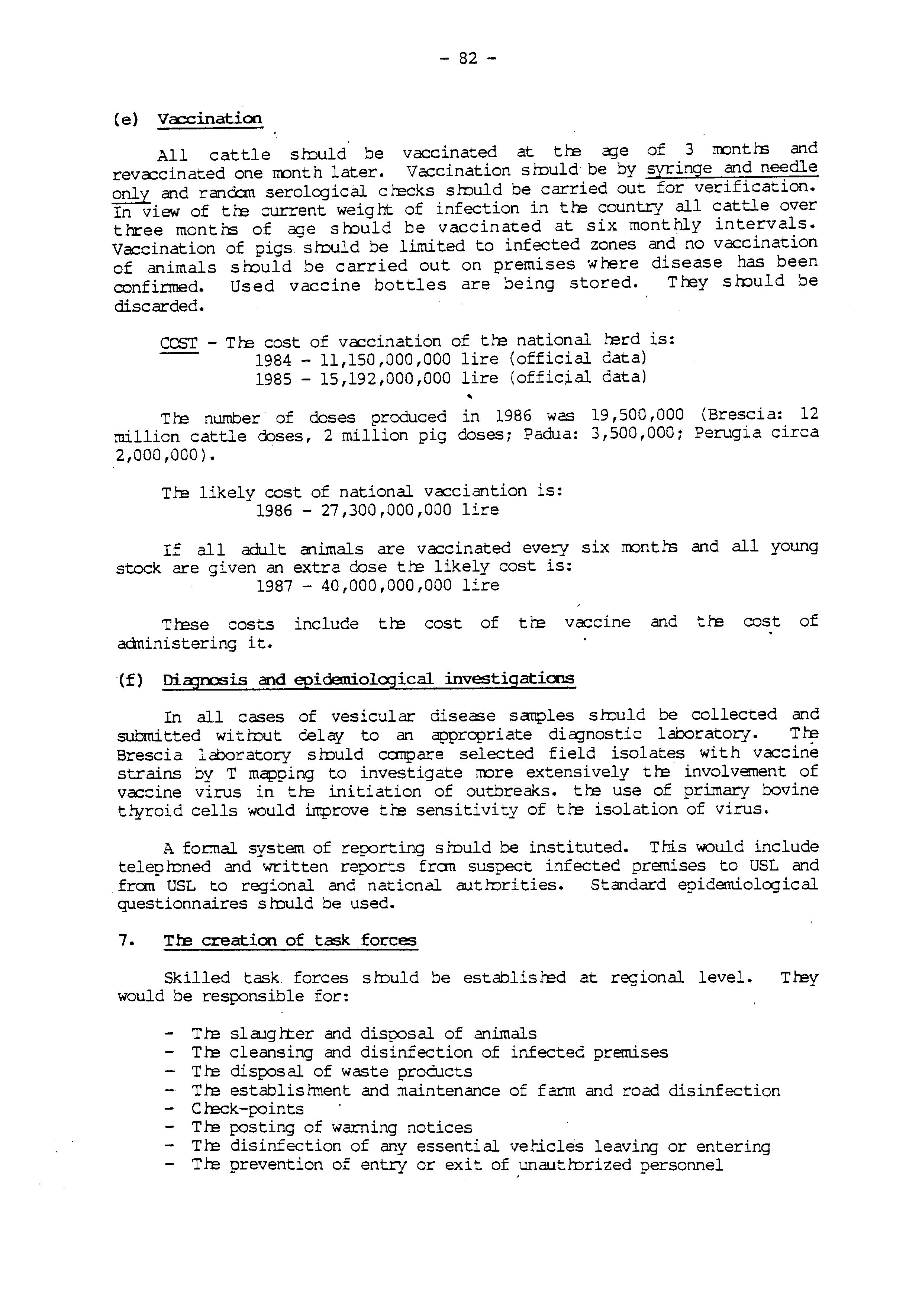
In all cases of vesicular disease sanples srould be collected and submitted witrout delay to an appropriate dia:;;;nostic laboratory. T.te Brescia laboratory srould canpare selected field isolates with vaccine strains by T mapping to investigate rrore extensively t.te involvement of vaccine virus in t.te initiation of outbreaks. tre use of primary l::ovine tlyroid cells would improve t.te sensitivity of t.te isolation of virus.
A fo.cnal system of reporting smuld be instituted. This would include telep.toned and written repor":.s fran suspect infected premises to USL and fran USL to regional and national autrorities. Standard epidemiolcgical questionnaires smuld be used.
7. Tre creation of task forces
Skilled task. forces s.tould be establis.ted at re;ional level. T.tey would be responsible for:
- T .te sl aug h:er and disposal of animals - T.te cleansing and disinfection of infected premises
Tre disposal of waste products - T.te establishnent and :naintenance of farm and road disinfection
C.teck-points - T.te posting of warning notices - T.te disinfection of any essential vehicles leaving or entering - T.te prevention of entry or exit of _unautrorized personnel
A task force which has carried out these duties ( in-part) has been used in the Pierronte region.
In addition epide:niolcgical tea:ns smuld be created to support regional auth:Jrities. They would include veterinary virologists and teclnicians fran tl:e national FMD laboratory, and meteorolcgists faniliar with the operation of canputer systems for analyzing and predicting the airborne spread of FMD. In tre event of an outbreak the epidemiolcgical team would be sent to infected premises with:Jut delay. It would be responsible for the following:
( a)
(b) (c) ( d) determination of the extent and pattern of disease on the premises determining the source of infection assess probability of secondary spread advise veterinarian in charge of control procedures on risks to other · premises
The tean smuld be equipped with specialist vehicles and radio-pmnes.
a. Prospects for control of tl:e present FMD epidemic
We have heard it said that the FMD situation in Italy is now "endanic". If by this it is meant that the presence of disease is taken for granted and that it cannot be eliminated in the foreseable future we do not a:;;iree.
If firm measures are taken as outlined in para 6. above the present epidemic could be contained within the 1987/88 financial year, particularly in view of the recent intensification of national vaccination. The infection could be completely extinguished if total stamping out is applied, particularly wren the epidemic is in its declining phases. Thereafter the maintenance of intensive vaccination for sane years, in the cbsence of active disease, smuld eliminate any possible carrier animals.
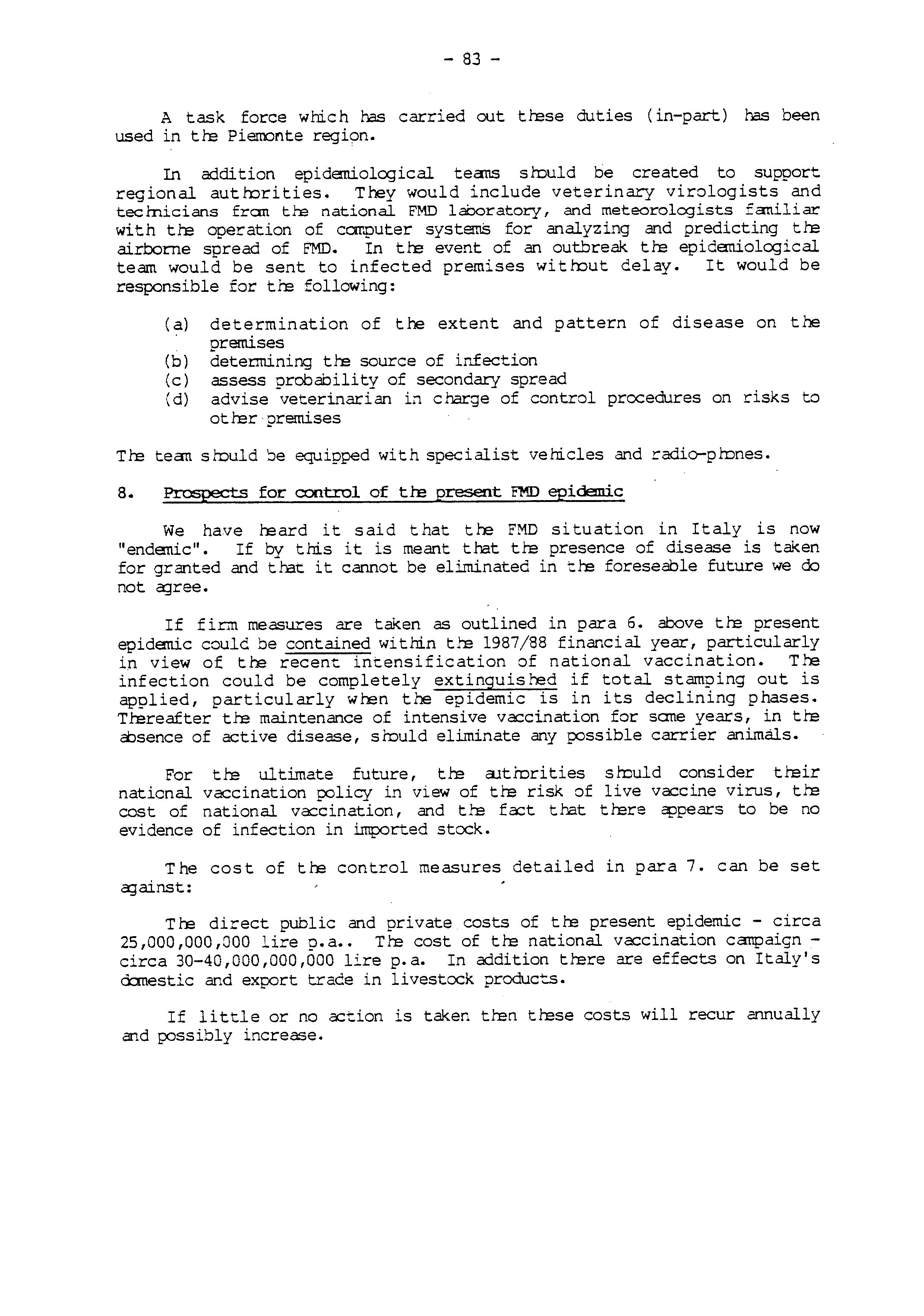
For tre ultimate future, tre a.itrorities smuld consider their national vaccination policy in view of the risk of live vaccine virus, the cost of national vaccination, and the fact that there cppears to be no evidence of infection in imported stock.
The cost of the control measures detailed in para 7. can be set a:;;i ains t :
The direct public and private costs of tte present epidemic - circa 25,000,000,000 lire p.a •• Tte cost of tte national vaccination ca:npaign circa 30-40,000,000,000 lire p.a. In addition ttere are effects on Italy's ocmestic and export trade in livestock products.
If little or no oction is taken tten these costs will recur annually and possibly increase.










